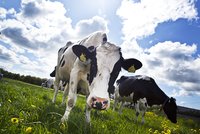Towards low-impact high-yielding cows
Burps, behaviour, blood and milk are some of the traits that can give us an indication of how efficient and eco-friendly a cow is. Scientists at Aarhus University are developing tools that can identify the most cost-effective cows. This will benefit the farmer’s economy and the environment.

A direct route to improving the farmer’s economy and give a helping hand to the environment with no adverse effect on yield is to improve cows’ feed use efficiency. The feed for cows makes up 70 per cent of the variable costs in dairy production, so even small improvements will have a large effect on the economy.
It is not as yet possible to measure feed uptake on individual cows in commercial dairy herds, but a number of other traits are being measured from which this could be deduced. Scientists at Aarhus University are currently participating in a new project on the development and implementation of a tool for the selection of cows that make more efficient use of the feed and are more eco-friendly. In addition to this tool, the project will implement and expand the knowledge of the concept on commercial farms.
The project is a collaboration between Aarhus University, the private company VikingGenetics (project leaders), SEGES (formerly the Knowledge Centre for Agriculture), RYK and FOSS. It is precisely the combination of research, commerce and consultancy that will pave the way for the development, implementation and dissemination of the new way of selecting the best cows.
Belches, blood and milk
Feed conversion can be improved by using genetic selection, but it is difficult and expensive to measure feed efficiency directly under practical conditions and on a large scale.
- Accurate measurements of the feed intake of cows is only possible at research facilities and on smaller scales. But you can approach the measurement of feed intake in cows from another angle by measuring the properties that have a correlation with feed intake and by combining data on the hereditability of traits and their mutual hereditary contexts, explains Senior Researcher Jan. Lassen from the Department of Molecular Biology and Genetics, Aarhus University.
The properties – the so-called indicators – that can give an idea about feed conversion are the cow’s respiration; in other words, her belches, milk and blood profiles, and the cow's behaviour and activity. These properties are hereditary and can be measured accurately and on a larger scale, and in some cases a range of information about heritability and correlations are already available in databases.
For example, we know that up to 10 percent of the energy that a cow discharges is emitted as methane-rich burps. How much methane a cow burps is controlled by both genetics and the environment. Selection for lower emission of methane will also lead to the selection of cows with a higher feed use efficiency or produce cows that have more energy for other things, such as production.
When you can select for cows that have a lower feed consumption, without reducing their milk yield, you automatically select for cows that emit less methane – and this benefits the environment, because methane is a potent greenhouse gas that has a large effect on the climate.
Good commercial potential
In addition to developing a genetic selection tool that makes it possible to select for climate-friendly and economic cows, the project participants will develop new biometric methods that can handle this type of data and quantify the economic value of the trait and thus the added value for the farmer.
- Properties that have a connection to feed efficiency and greenhouse gas emissions are currently not a direct part of the breeding work in dairy farming. Our results therefore have great potential to strengthen demand for the Nordic dairy cattle breeds when farmers are looking for cows with a high total economic performance, says Jan Lassen.
The four-year project has a total budget of 26 million DKK, to which the Green Development and Demonstration Programme of the Ministry of Food, Agriculture and Fisheries has granted 15 million DKK. The project, called Robust and efficient dairy cows (REFICO), is headed by Viking Genetics. The other partners are Aarhus University, SEGES (formerly the Knowledge Centre for Agriculture), RYK and FOSS.
For further information please contact:
Senior Researcher Jan Lassen
Department of Molecular Biology and Genetics, Aarhus University, Denmark
e-mail: jan.lassen@mbg.au.dk, telephone: +45 8715 7936
